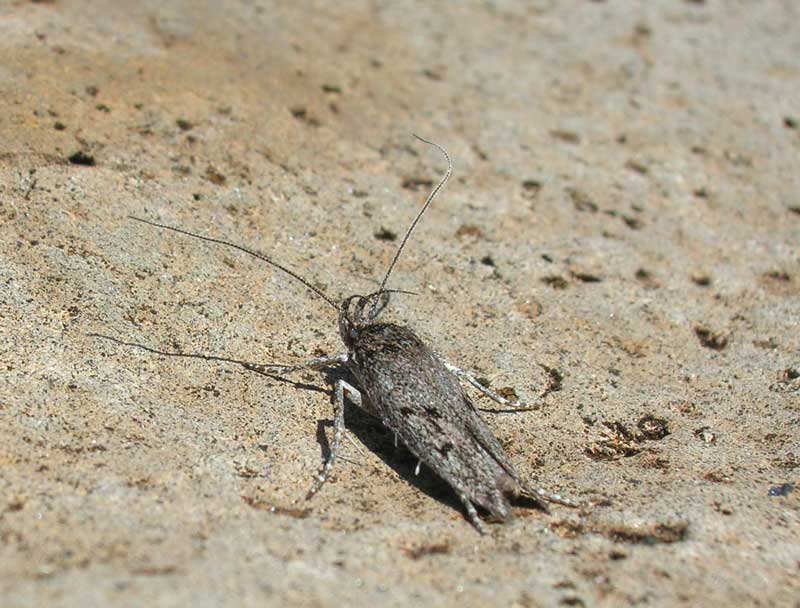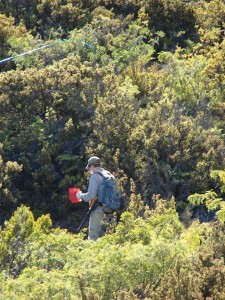
The flightless moth of Haleakalā is one of the more dramatic examples of evolution in Hawaiian insects. Photo courtey of Forest & Kim Starr
The flightless moth of Haleakalā is one of the more dramatic examples of evolution in Hawaiian insects. Known to science as Thyrocopa apatela, this moth lives only on the barren slopes of Maui’s highest peak. As caterpillars, they spin webs in rock crevices to catch dead leaves blowing past for food. Adult moths hop like grasshoppers across the ground – up to 10 times their body length. Though its evolutionary ancestors could fly, the adults of this species have only partial wings. This unique behavior may have evolved as a result of environmental conditions: high winds and cold may have meant that flight was not an advantage for the moths.
In Hawaiʻi, the climate varies dramatically from one area to another within a short distance. Even if the drizzle never lets up at your house, it could be sunny all day a half mile away. These microclimates create a variety of habitat types that plants and animals have evolved to take advantage of, the tiniest residents included. Native insects and spiders often specialize to survive in their tiny piece of paradise, resulting in the amazing adaptations seen among Hawaiʻi’s insects and spiders.
Of the native Hawaiian insect species, an estimated 98 percent are endemic—meaning they are found nowhere else in the world. Arachnids (spiders) follow suit; an estimated 96 percent of Hawaiian spiders are endemic. The changes that the crawling and flying critters have undergone after arriving in the islands have been dramatic, in part because there are so many varied environmental conditions in a limited area. An ecological niche may be left open that an insect species rapidly adapts to fill.

Researchers have been evaluating potential control measures for the invasive Argentine ant. Photo by Forest and Kim Starr.
But today, exotic predators prove to be one of the greatest threats to the flightless moth and other creatures in the alpine environment. The Argentine ant, Linepithema humile, arrived in Hawaiʻi in 1940, most likely by hitching a ride in military cargo. First detected at Fort Schaffer on Oʻahu, people then unwittingly spread Argentine ants throughout the state; by 1967 ants had been carried to Hosmer’s Grove. Hawaiʻi has no native ants and his alien ant is one of 50 plus ant species accidentally introduced to Hawaiʻi but while most ants live in lower elevations, the Argentine ant prefers the cooler climates of higher elevations
The insects and spiders found in the alpine ecosystem belong to a greater system: the yellow-faced bee and a Hawaiian noctuid moth pollinate silverwords; the silverswords in turn provide habitat for the Hawaiian long-horned beetle, a plant hopper, and the tephritid fly. Extremely rare carabid beetles scavenge a meal from whatever comes their way-researchers only recently rediscovered some of these species, once thought extinct, on the slopes of Haleakalā. The predatory Argentine ant could wipe out this food web shaped over millions of years of evolution. Regular monitoring of Argentine ant populations in Haleakalā National Park has shown that in areas where the invasive ant is present, insect diversity drops by 50 percent and overall insect abundance drops by 65 percent.
Since people first introduced the Argentine ant o Haleakalā, it has spread quickly from the small infestation in Hosmer’s grove. In 1982, a second infestation was found near the Kalahaku overlook on the crater rim. Since Argentine ants don’t have a mating flight, the ants most likely hitched a ride when people inadvertently moved nest material. In Haleakalā National Park the Argentine ant has spread at rates exceeding 150m per year; left unchecked, the ant could cover 75 percent of the subalpine shrubland and Haleakalā crater—critical habitat for many native Hawaiian species.
Researchers have been evaluating potential control measures within the park, particularly for source infestations, such as campgrounds, from which people may unintentionally spread the ant. You can help by making sure your gear and picnic supplies are clean and free of all ants, Argentine or not, that you may have picked up elsewhere in your travels.
Learn more about the native insects on Haleakalā and how the Argentine ant threatens them at http://www.hoikecurriculum.org/unit/good-critters-bad-critters/
Lissa Strohecker is the public relations and education specialist for the Maui Invasive Species Committee. She holds a biological sciences degree from Montana State University. Kia’i Moku, “Guarding the Island,” is prepared by the Maui Invasive Species Committee to provide information on protecting the island from invasive plants and animals that can threaten the island’s environment, economy and quality of life.
Originally published in the Maui News, January 11th, 2015 as part of the Kia‘i Moku Column from the Maui Invasive Species Committee.
